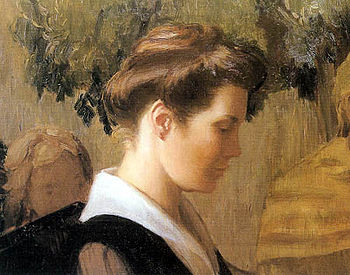 |
| "The witch no. 1" lithograph (Photo credit: Wikipedia) |
What was life like for the New England Puritan?
The people were floundering about, trying to find purpose. Until about 1660, Americans had a common goal; working together to forge a new frontier, but now the colony was well established and attention turned to gain, both materially and spiritually.
Colonists did not care for the English political leaders. Instead, people idolized the founding fathers, like those who came over on the Mayflower. In 1692, the founding fathers were dead and gone.
The majority of the population had always been born in England, but the tide changed, and in the late 1600's, America was filled with people born on her soil.
There was no separation of church and state, and people who did not attend meetings were suspect and could be punished. Many towns had a rule that a man could not vote if he was not a member of a church.
Because lying was considered a sin, it was punishable by law.
Hangings were not common, but when one occurred it was a form of entertainment that young children were encouraged to attend. The most popular part of the hanging was the last words when the person about to be executed would say goodbye to his or her family. Puritans reasoned allowing children to witness hangings would teach them the consequence of immoral behavior.
Life was an exhausting array of chores with little amusement. The average family made their own bread, butter, cider, ale, clothes, candles, and just about everything else they used. Every member of the family could expect to work from morning to night.
Houses were dark, damp, and depressing. A candle was always burning, even in the middle of the day because the tiny windows let in so little light.
The nearest neighbor usually lived a few football fields away.
Most people could not write, and signed their names on legal papers with their "mark." Signing an "X" was unfashionable to young girls (and even grown women), who liked to make curly cue hearts and other inventive designs.
Because people couldn't read, they didn't care (or know) how their name was spelled, and, since the court reporter couldn't very well ask an illiterate person how to spell his or her name, the spelling depended on who was taking the notes. Many of the official documents spell individual names differently. Mary Easty was also Esty, Osborn, Osburn, Cory, Corey, and so on. Even learned and educated men used a loose grammar, and did not worry about proper spelling.
Normal families had 5-10 kids of their own, and it was common to have an extra child living in the home. By the age of 7, children were given their full share of responsibility and expected to perform to adult standards.
New England had one of the lowest rates of infant mortality in America. "Nine out of ten infants born there survived at least until age five, and perhaps three-quarters lived to see adulthood." In more rural areas as many as 25% of children died before the age of 1, and only about half made it to adulthood.
Most marriages ended with the early death of a spouse. A couple was lucky to get seven years out of each other. Second and third marriages were common.
The man was head of the household. A woman might offer her opinion to her husband behind closed doors, and even prove a valuable ally, but she was expected to concede to her husband in all matters. She could not own property without her husband's permission, or vote. It was assumed that woman was the weaker sex in every way, and if she did not follow her husband's rules, he was encouraged to use physical abuse as a form of "correction."
There was a real fear of Indians (Salem was never attacked), and everyone knew at least one orphan from Maine who watched on as their parents were killed by Indians. Ironically, many people who were captured and held captive chose to stay with the tribe rather than go back to their families.
Politics
America was a colony of England, and had to run things according to a set of rules, called a "Charter," handed down from the English king. Just to get word to England would take 10 weeks by ship. In March, when the witch scare first broke out, the previous charter had been long eliminated. This meant there was no leader, no rules, and the nearest thing to a leader was in England negotiating for a new charter. Because of the situation, the accused witches were examined and held in jail, but not tried. In May, Increase Mather, the president of Harvard (the only New Englander with an official title), sailed back from England with a new charter and a new governor. This is when the actual trials began.
Puritan Beliefs
The Bible was law; period, no questions asked, end of a conversation. It was taken literally, and sins like adultery and sodomy could be punished by death.
 |
| "The House Where Witchcraft Started, Now Danvers, Mass." (Photo credit: Wikipedia) |
The Puritan faith had been taking some blows, and there were no new people joining the ranks. Ministers were constantly preaching about the falling ranks and the rise of the devil as if they were one.
Ministers commonly spoke of the virtue of being a good wife, which was all a woman could really hope to be. A woman would be frowned upon if she owned her own land, didn't have a lot of children, or was in any way, outspoken or different.
People dabbled in the occult and practiced white magic. Simple wives tales like fortune telling were passed down from generation to generation, though it was considered evil. Ministers were always preaching about the dangers of inviting the devil in through the occult, no matter how harmless it may seem.
There was a general distrust at the time, and if a cow suddenly died, its owner would likely think one of his neighbors had cursed him. A man would not dare to question God's judgment; he just questioned it being aimed at him. If he searched his soul and found he had done nothing to deserve the death of his cow, he would blame the misfortune on the devil acting through a witch.
To deny God was unquestionable, so by the same token, to deny the existence of the devil would be just as blasphemous. The Bible was taken to be complete truth, and men who could read would consult the Bible for personal, as well as legal matters.
Puritan lifestyle was stringent and righteous, and they were not the loving and forgiving type one would expect to meet in such a religious community. According to Marion Starkey, if a man had a toothache the Puritans figured he had in some way sinned with his tooth. This feeling was so strong that some of the accused witches confessed in bewilderment and wracked their brains to find something they had done in the past to allow the devil to use them in such a manner.
The Puritans used fasting as a means to give God a little extra oomph and unite the community in a cause. Meals were very important, and usually the only time during an average day when a person could sit and relax for a moment.
There was little separation between dreams and real life. To the Puritan, there was a reason for everything, and "...dreams contained prophesies, revelations, truths more real than daily life, and there was no clear explanation of what else they were."
Salem Village
All his life, Thomas Putnam had been resentful of rich families, like the Porters. Both families grew up in Salem Town, but the merchant Porters were more worldly and successful than the farming Putnam's. No matter how hard he tried, Thomas Putnam, an influential man in his own right, just couldn't beat those uppity Porters. The Porters had more land and more money, but what really bothered Thomas was that the Porters were considered smarter than the Putnam's because they were better spoken. Thomas set out to break away from Salem Town and from Salem Village, but the township wasn't eager to let the property go.
Salem Village was allowed to build a meetinghouse, but it was to act as a franchise of the Salem Town meetinghouse. Thomas Putnam tried to pull rank by handpicking the ministers, but this only served to divide the community in half; those who supported Putnam and his choice of theminister and those who hated Putnam and wouldn't support any choice he made. All the unsuspecting ministers would eventually leave Salem Village because of the conflict. Sometimes, Salem Town/Village would refuse to pay, (George Burroughs had to take a suit to the General Court in order to get paid) and sometimes the ministers would bow out, frustrated by all the arguing and infighting.
Salem Village was finally allowed to act on it's own, and Samuel Parris was the first minister to hold the job for the budding community.
The witch, according to the Salem Puritan.
Witches were notorious for killing otherwise healthy infants.
Witches had pets, known as "familiars," to do their evil bidding. The familiars would drink the blood of their witch masters from an extra "teat" located somewhere on his or her body, usually near the genitals. Salem familiars had the particular habit of sucking between the index and middle finger.
Witches could throw curses like Frisbees, aiming at anyone who irritated them.
Witches made a pact with the devil, sometimes for a specified amount of time. The devil was always tempting people into signing his book.
A witch could not say the "Our Father" prayer without making mistakes.
A witch could be in one place while her specter was causing pain and mischief in another.
The devil had no power over those who didn't give him permission. He could not assume the shape of a righteous person, though the Puritans had no valid reason to believe this and many argued over the use of "spectral evidence."
If a person was convicted, or even accused of being a witch, his or her family was automatically suspect.
|

















